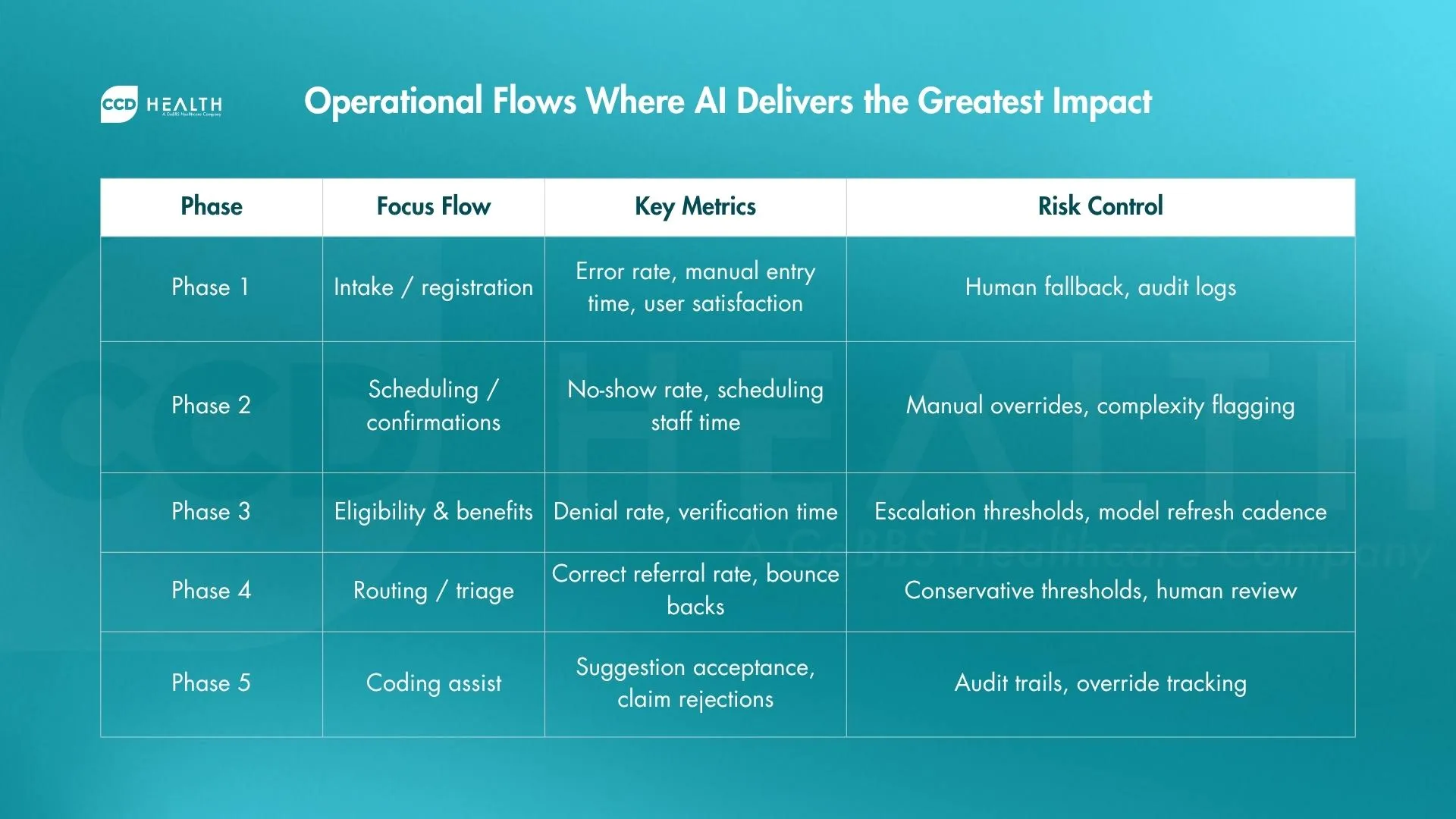Where Providers Should Focus AI Efforts: 5 Key Operational Flows to Automate

AI adoption in healthcare is growing, but where does it actually make sense to use it and see real improvement?
When it comes to implementing AI in healthcare, patient intake and appointment scheduling are the best places to begin. These workflows are universal, consistent, and well-structured, making them ideal for early automation. Starting here allows providers to adopt AI gradually and build trust in the technology without touching clinical processes. As teams grow more comfortable, it becomes natural to extend automation into insurance verification, triage and routing, and coding support.
The key is to think of AI not as a replacement for your staff, but as a way to take the weight off repetitive processes so your teams can focus on the parts of care that truly need human judgment.
Why Intake and Scheduling Come First
A 2024 survey found that 86% of health systems are already leveraging AI in some part of their operations, a clear sign that the shift is well underway. But this use is in many cases, not strategid. The best way to change this is to focus the use of AI in areas that touch every patient and every team member: patient intake and appointment scheduling.
Every patient begins their journey with a call (or portal visit) to schedule, making scheduling high-volume and predictable, perfect for AI to lend a hand. Small inefficiencies here ripple across the entire care journey and a small improvement here can free up several hours of staff time each week.
-
Reduced manual data entry
-
Immediate feedback: Mistakes show up quickly, so you can catch them fast.
-
Measurable ROI: Cutting down on errors and no-shows pays back quickly.
AI Implementations: Top 5 Operational Workflows
Patient Intake
Patient intake is notorious for being time-consuming: stacks of forms, repeated questions, and plenty of data entry. AI can smooth this out by reading free-text responses, flagging missing information, and reducing back-and-forth with patients.
-
Better data capture: AI can turn messy free-text answers into structured data fields.
-
Fewer errors: Missing birthdays, mismatched insurance IDs.
-
Less patient fatigue: Ask only what’s needed, and make it smoother.
-
Staff support: When AI isn’t sure, it passes the case to a person, not the trash.
The result is a process that’s faster for patients and less of a grind for staff, while still keeping humans in control of final checks.
Automating Scheduling and Confirmations
Scheduling is often one of the most frustrating parts of healthcare, for patients and for staff. AI can help here by predicting optimal time slots, sending reminders, and even managing waitlists in real time.
-
Smarter scheduling: Suggests times based on history and preferences.
-
Automated reminders: Fewer no-shows with SMS or email nudges.
-
Waitlist management: When someone cancels, the next patient can slide right in.
-
Conflict prevention: AI flags potential double-bookings before they happen.
In our experience, for example, using Pax Fidelity™ – an AI-Driven Protocol Identifier, we improved scheduling efficiency for an imaging center. The results? 15.83% more calls per hour and 15.74% more appointments per hour . That’s the kind of impact you get when AI supports operations, not replaces people.
Insurance and Eligibility Verification
Once intake and scheduling are running more smoothly, a smart next step is insurance verification. Anyone in healthcare knows the pain of denied claims due to missing or incorrect information. AI can help by reading payer policies, checking eligibility in real time, and flagging potential issues.
-
Catch errors early: Verify coverage before the visit, not after.
-
Reduce denials: Clearer, cleaner information means fewer rejections.
-
Faster checks: Patients know their financial responsibility up front.
-
Continuous learning: AI gets better at spotting patterns over time.
This step not only improves revenue cycle performance, it also saves your staff from hours of back-and-forth phone calls with payers.
Patient Routing and Triage
A little further down the road, AI can start helping patients find the right place to go in your system by supporting decision-making about where a patient should be directed.
-
Guided questionnaires: Simple symptom checkers to point patients to the right clinic.
-
Smart routing: Patients with clear red flags (like chest pain) are escalated immediately.
-
Reduced misdirected visits: More patients land in the right place the first time.
-
Staff relief: Fewer unnecessary transfers between departments.
This is where extra caution is needed. The stakes are higher, so AI should always act as a guide, with humans reviewing edge cases.
Supporting Coding and Billing
Finally, when you’re ready for it, AI can help with coding and billing. It can suggest CPT or ICD codes based on the intake and clinical notes, highlight mismatches, and reduce the amount of manual searching coders need to do.
-
Faster coding: Suggestions speed up workflows.
-
Error reduction: Flags mismatched codes before submission.
-
Audit support: Creates clear trails for compliance checks.
-
Human control: Coders confirm or override as needed.
AI is About Efficiency, Not Replacement
AI is here to make processes smoother. Intake staff, schedulers, and coders bring judgment, empathy, and experience that no algorithm can replace. AI just clears away the repetitive parts so those professionals can focus where they’re most valuable.
-
AI reduces tedious data entry.
-
Staff get more time for patients.
-
Processes become faster and more consistent.
-
Patients experience less frustration.
Our CEO, recently spoke about this philosophy, making the case for how AI improves healthcare scheduling by supporting staff. That mindset has been key to successful implementations and to building trust among staff.
For organizations slowly adopting or starting to adopt AI, the message is clear: don’t aim for the flashiest or most complex use case. Begin with what makes sense for your overall process, whether that’s scheduling, billing, and then grow into other areas.
Start small, measure carefully, and keep humans at the center. Done right, AI becomes a powerful partner in making your processes more efficient, your staff less overwhelmed, and your patients better served.
To learn more about how AI-driven patient scheduling can help an organization grow, download our latest case study.




